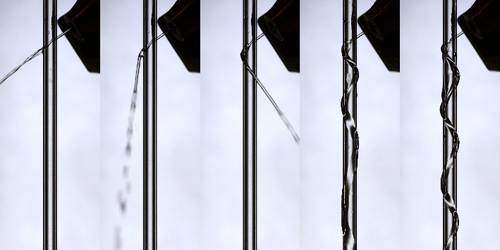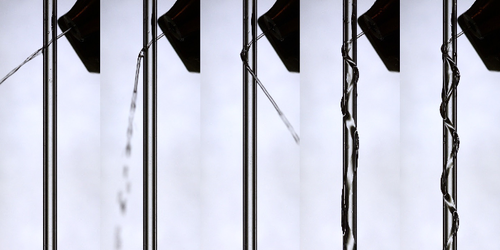Liquid Jet Coils Around Cylinder
Pour hot tea too slowly from a teapot and the liquid dribbles down the pot’s spout and onto the table. Now, Etienne Jambon-Puillet from the University of Amsterdam and colleagues show that water jets can also trace more complex paths as they cling to curved surfaces and fall to the ground. The demonstration transforms the everyday annoyance of the “teapot effect” into a fun phenomenon, but it also has a serious side. The team says that knowing when a fluid jet will stick to spout-shaped surfaces could help reduce this typically unwanted effect both in the home and in technological applications, such as 3D printing.
In their experiments, Jambon-Puillet and colleagues directed a water jet at an angle of 30° towards one edge of a vertical glass cylinder with a diameter of 3 mm. At high flow rates—over 1 ml/s—the cylinder had little impact on the jet’s straight path. As the team lowered the flow rate, they noticed that the jet started to deflect around the cylinder. Decreasing the flow rate further, to around 0.5 ml/s, they found that the deflection turned to coiling, with the jet suddenly “clinging” to the cylinder and spiraling around its wall in a helix-like pattern.
The team repeated the experiments using a cylinder made of Teflon. They also varied the cylinder’s diameter and other experimental parameters. In all cases, they observed the same behavior. The team then developed a model that successfully predicts the threshold flow conditions for this jet coiling, a tool that could allow teapot and printer makers alike to design devices that avoid this effect.
This research is published in Physical Review Letters.
–Katherine Wright
Katherine Wright is a Senior Editor of Physics.





